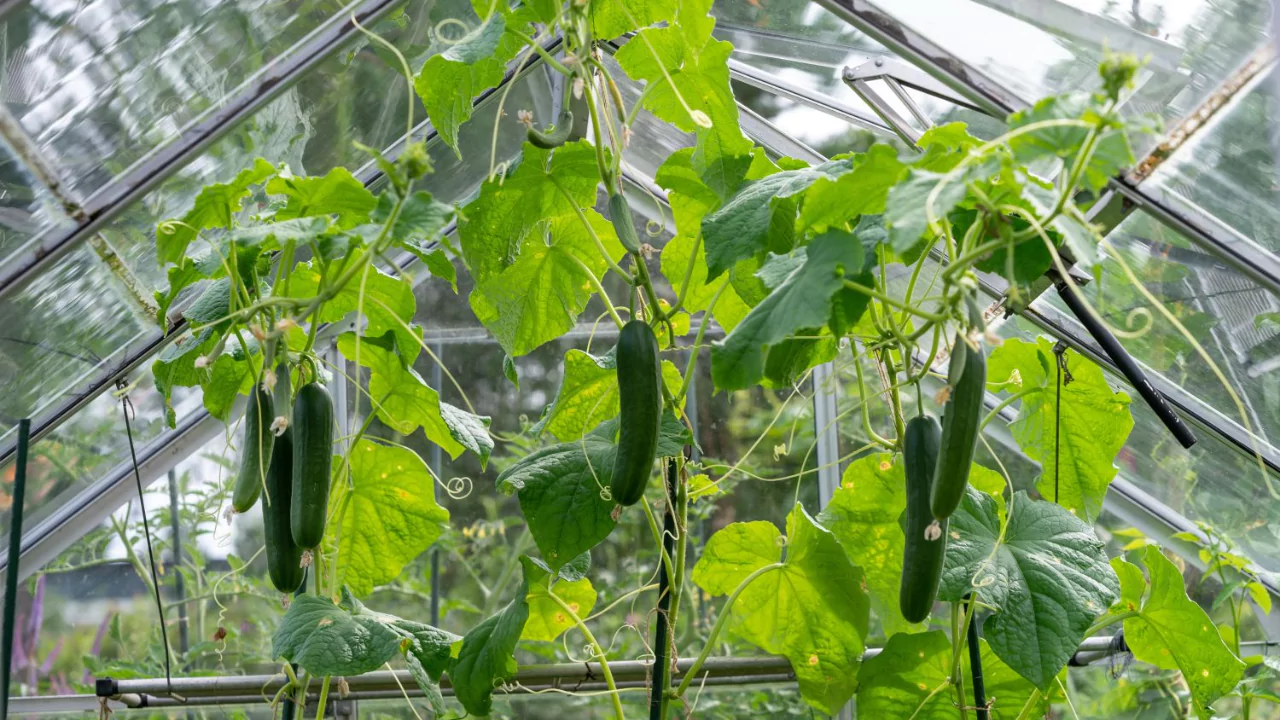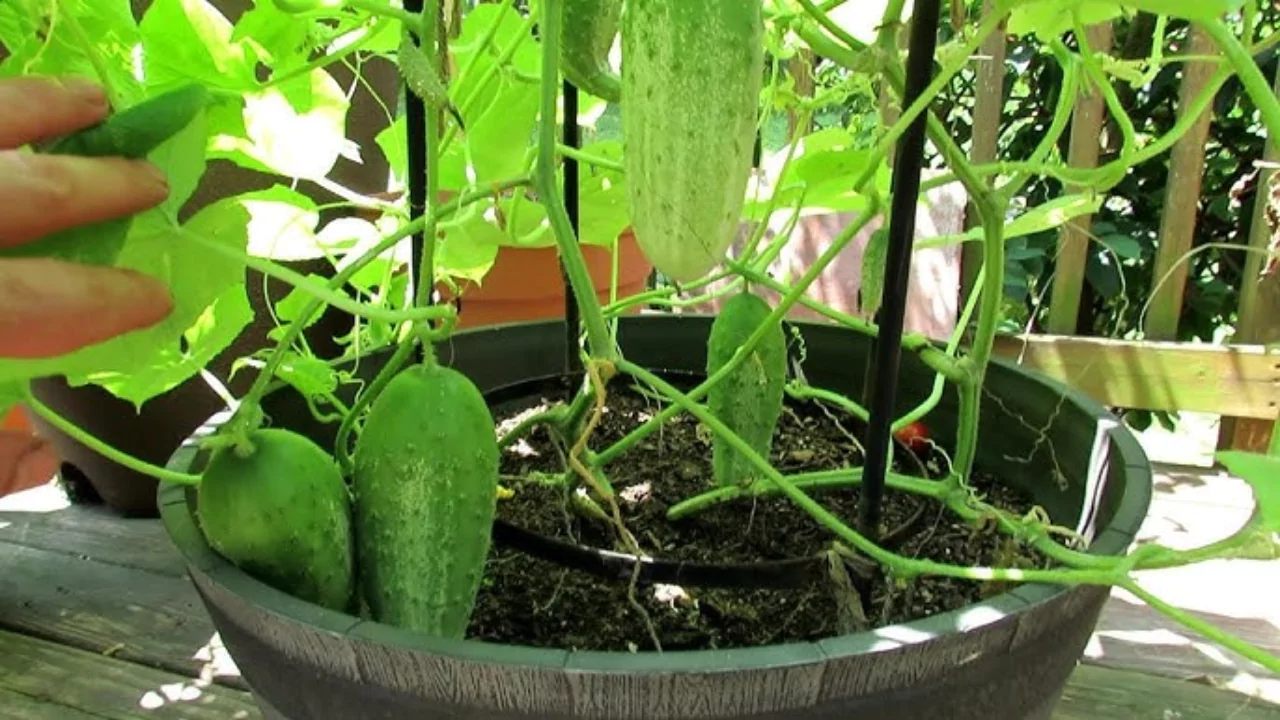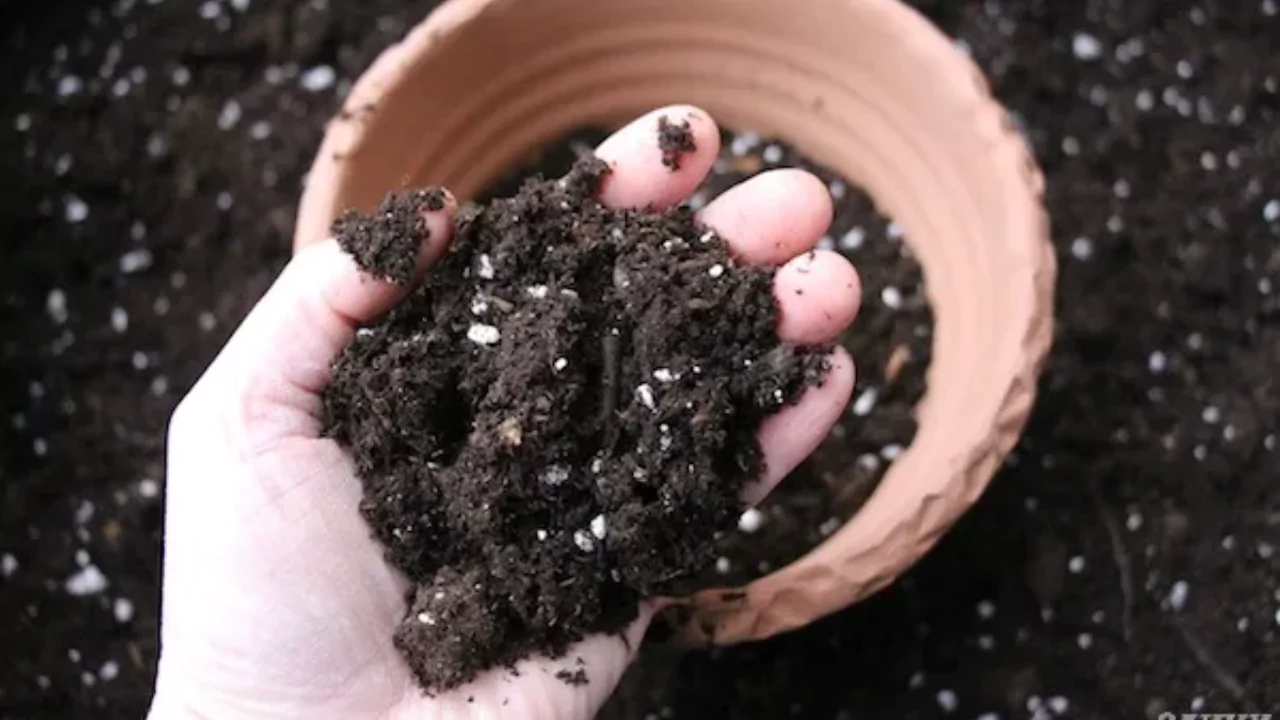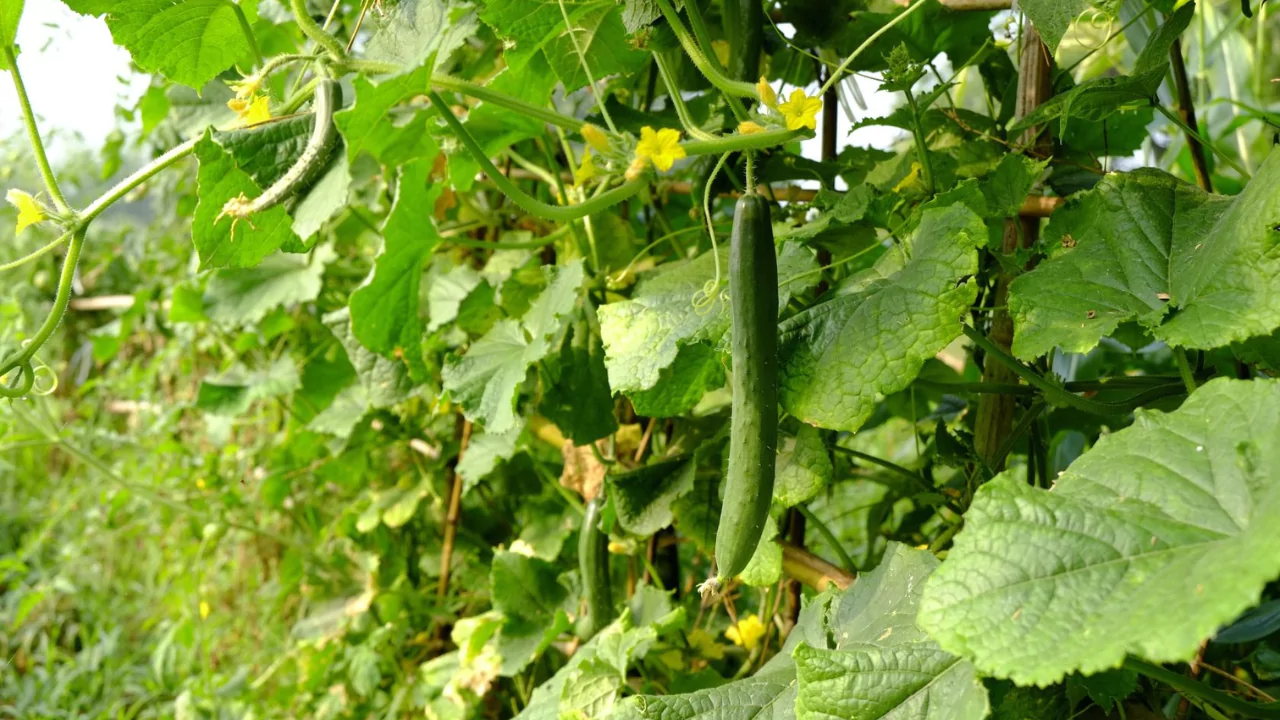
Lack of space for cucumber cultivation? No problem, you can still grow fresh cucumbers for your salads. While cucumber vines may become somewhat tangled in containers, beside this complication they are quite easy to grow in pots.
Cucumber, Cucumis sativus, is one of the most known representatives of the family Cucurbitaceae. Other notable relatives include squash and bitter melon.
Cucumbers are primarily creeping vines; their growth consists of rooting in soil and climbing up supports such as trellises via tendrils. In the absence of these supports, they sprawl horizontally and cover ground.
Botanically speaking, a cucumber is fruit—a special kind pepo berry featuring a hard outer layer without internal parts. Similar to tomatoes or squashes—fruits that many consider vegetables—we mostly treat it as a vegetable in our diet.
Cucumbers have refreshing taste with mild flavor and over 90% water content. Cucumber supplies small amounts sodium, cholesterol and calories making it an ideal healthful product alongside other nutrients.
What are the Different Types of Cucumbers?
The two main types of cucumbers are: pickling and slicing. The two styles are Bush and Vining.
Pickling cucumbers are smaller than slicing ones but make better pickles compared with larger slicing cucumbers which excels when used in salads or consumed raw straight from fields.
| Pickling Cucumbers | Slicing Cucumbers |
| Distinguishing Features: Shorter and thicker than slicers. Usually have uniform width and length Skin color ranges from dark green at the stem end to yellow or pale green at the blossom end. The skin is thin, bumpy, with little to no wax. | Distinguishing features: Larger in size, 6-9 inches long. May contain slight bitterness in taste which can be lessened by peeling and deseeding. Skin color is uniformly dark green waxy and tough. |
| Well known varieties include: Gherkin a.k.a. Cornichons Boston pickling cucumber Bush pickle Wisconsin SMR | Well known varieties include: Kirby Straight eight Lemon cucumber Diva hybrid |
Bush and vining refer to How cucumbers assume form styles these styles assume.
Vining refers to spreading out into long vines while bush denotes compactness.
Bush types are suited for containers as they are more robust and adapt well to pots but need extra support from trellises and teepees.
What are the Best Cucumber Varieties for Growing in Containers?

Under normal conditions, cucumber vines spread out and grow in tangled masses. However, with the use of containers, the vines can be trained to grow up a trellis or other supporting structure.
This minimizes the possibility of infection by soil-borne fungal diseases and pests.
The most popular cucumbers for container gardening include:
- Sweet Success
- Suyo
- Salad Bush
- Bush Slicer
- Burpless
- Liberty
- Early Pik
- Salty and Crispy
These varieties are sure to get a gardener’s thumbs up from all corners of the earth.
How to Choose the Right Container to Grow Cucumbers
Cucumbers require containers that are deep and rich with fertile soil. They should be at least 12 inches wide and 16 inches deep.
With ample space within a large container, the plant can develop an extensive root system. This will potentially lead to vigorous growth as well as higher yields.
A good rule of thumb is: bigger is better! Experts suggest that even just two additional inches of depth can mean twice the harvest.
Your cucumbers won’t dry out in self-watering planters but you will have to keep an eye on soil moisture levels.
A pot that is 20 inches in diameter can accommodate four to six cucumber plants. A five-gallon pail will allow for two to three plants while a deep ten-inch pot can grow one bush-type cucumber.
Cucumber plants may also be grown in rectangular planters and window boxes. However, these need to be accompanied by trellises so that the climbing plants have support.
What are the Ideal Conditions for Growing Cucumbers?
Apart from choosing the right containers, here are some other factors you need to achieve for healthy cucumbers:
Potting Soil

Fitness vertical view of plaster shelf modern garden design outline Do not use regular soil from the garden as it is dense, slow draining and may contain pests and diseases. Rather fill three quarters of your container with well drained soil mix rich in organic matter like worm castings or compost tea. This ensures ideal conditions.
For growing cucumbers, the ideal soil pH level is between 5.5 to 7.0. If your soil falls below 5.5 then use lime as a corrective measure.
Temperature
As warm weather lovers, cucumbers flourish best in sunny locations sheltered from strong winds.
Only plant them outdoors when the weather warms up, perhaps one or two weeks after the last spring frost. Cucumbers grow best in temperatures between 65 and 90 degrees Fahrenheit.
Moisture
Water is a key nutrient for cucumbers as fruits stem from over 90% water. In order to cultivate healthy cucumber plants, Regular deep watering is essential.
Also important while watering is keeping the leaves dry to prevent moisture-related fungal infections.
To enhance moisture retention, applying light layers of mulch around the plant’s base also works well.
Cucumbers Need Fertilizer

When planting, apply all-purpose slow releasing fertilizer with potting soil.
During flowering time, side dress growing cucumbers using balanced liquid fertilizer combined with aged manure. Female flowers thrive on added nutrients at that stage.
How to Plant Cucumbers in Containers
Step1: Set up pots’ support structures for growing cucumbers before they start germinating so you don’t run the risk of damaging young plants.
Alternatively, you can place a trellis behind the container.
Step 2: Blend in one inch of compost and loosen the soil to at least eight inches deep.
Step 3: In each pot, sow a group of 6-8 seeds at approximately 1.5 inches deep. Be cautious not to bury them too deeply, as this will hinder their ability to break through the surface post-germination.
Step 4: Once the seedlings have developed two sets of leaves, choose two or three of the most vigorous plants and either pinch or snip off the rest at ground level.
There is a strong urge to remove the extras and replant them, but that is unnecessary. Removing the seedlings will compromise the roots of the remaining plants.
Step 5: Ensure cucumbers are watered regularly so soil moisture is uniform. Aim for irrigation of about one inch over a span of three to four days.
Soil must never dry out completely as this will result in wilting for the plant.
Step 6: As cucumber vines develop, instruct them to climb up the support by helping them twine around it.
For vines that require assistance in securing to the support, you can softly tie the plant using soft, clean cloth strips.
Step 7: Add more mulch as the vines grow to help the soil retain moisture.
Step 8: Fertilize every two to three weeks with liquid fertilizer diluted to half-strength at the root zone during watering. Do not overfeed; this will result in excessive foliage and scant flowers and fruit.
Can you Grow Cucumbers from a Cucumber?
No, it cannot. If the plant is a hybrid variety then there is very little probability of producing an offspring resembling the original parent. Furthermore, even if it manages to grow, the fruit may either fail to set or revert form tendril shapre into one of its forebears.
However ,in case you select an open-pollinated cucumber variety, then such a seed is certain to germinate into a plant but might take significant time for doing so.
How to Care for Potted Cucumbers
Cucumbers need warmth and direct sunlight. Make sure your plants receive six hours of strong sunlight daily which ensures better growth and increased yield.
Remember that soil mixtures in potted plants shrubs dry out faster than ground garden soil. Cucumbers prefer soils rich in organic matter and nutrients.
Container size and plant spacing will also affect the amount of water required.
Humidity, temperature, and wind are other conditions to consider while watering the plant.
Best practice suggests checking every day, which is possible by inserting fingers into the top two inches of soil. If absent, provide slow even watering until excess water drains from the bottom.
Note morning watering is preferable compared to evening hours.
What is the Best Time to Harvest Cucumbers?
Cucumbers develop very quickly with a first crop available approximately twelve weeks after planting.
Check your tags or seed packets for optimal sizing since harvest timing depends on measure pointer heuristics cucumbers grow towards a specified length.
For some varieties of cucumbers, you can expect to harvest fruit that is four to thirteen inches long.
In general, pickling varieties are only a few inches longer while salad varieties do have an elongated appearance.
As with most cucumbers, the overripe specimens tend to become excessively bitter and full of seeds. Small fruits are often more delicious than larger ones.
Ideally, the harvest time for cucumbers is in the early morning before temperatures rise too high because of heat.
Make sure not to pull the cucumber off as it will damage the vine, instead use garden clippers or even a sharp knife works well.
While it’s mentioned only harvest what you can consume at that period of time unless they’re getting vast in size remember also the more you harvest more you’ll be able to consume later on.
Container-Grown Cucumber Pests and Diseases
Cultivating cucumber plants is generally straightforward, though there are a few challenges that you should be aware of.
Powdery Mildew
A fungal insfection called powdery mildew emerges as white patches resembling flour on the foliage of a cucumber plant. It is associated with high humidity and plant stress.
To mitigate infections, good airflow should be ensured, and any leaves or fruits that are rendered unwell by the disease should be removed. If the infection is persistent, any of these two home remedies can be utilized:
- Combine one teaspoon baking soda with a drop of liquid dish soap, both mixed into one quart of water. Spray Cucurbits with this solution.
This changes the surface pH of leaves and makes them hostile to mildew spores. - One part cow’s milk mixed with nine parts water also works well when applied as a spray foliant after rains.
Milk has enzymes which inhibit fungus growth.
Cucumber Beetles
These fast yellow and black beetles munch through commercially important crops like cucumber- targeting not only stems but also fruits and flowers. Thankfully, they are easy to control.
To manage their growth, spray neem oil and get rid of the orange eggs deposited on the undersides of leaves.
Squash Bugs
These bugs have brown to grey coloring and large sizes that allow them to be easily removed from cucumber plants, though they do damage the fruits by sucking juices from the leaves and stems.
Luckily, they are fairly sluggish which helps in their removal via soapy water drownings. In addition to the aforementioned techniques, try protecting your seedlings with garden fabrics until flowering initiates. Some pests are vectors for certain diseases which also enhance their significance.
The ability to encourage any plant in your garden is helpful but comes with a multitude of challenges. Every day during the summer can be optimized provided that you put in effort despite all the factors working against you.